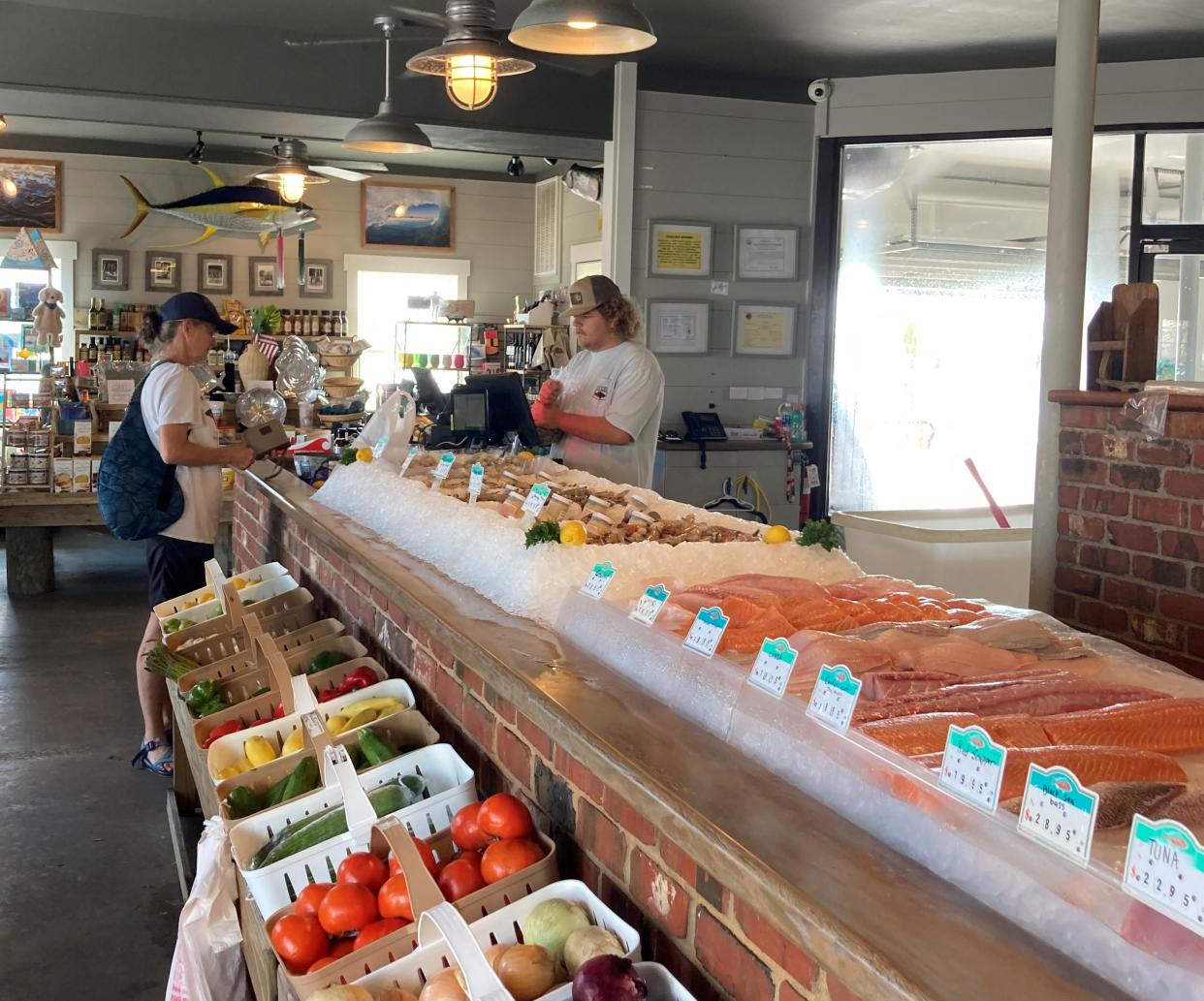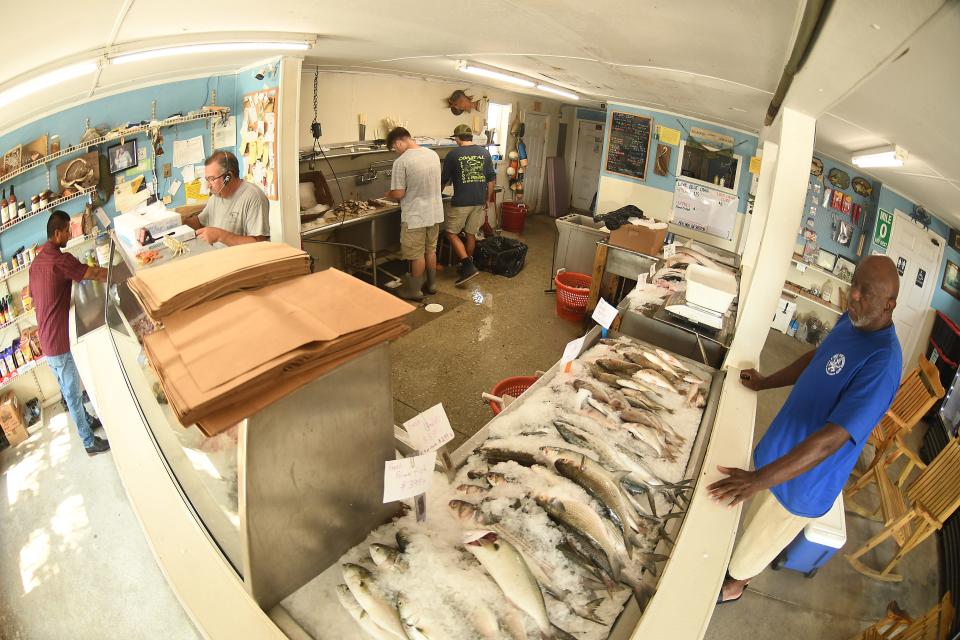Looking for the freshest catch? Here's how to buy local seafood like an expert

Without a doubt, one of the best things about living in Southeastern North Carolina is the abundance of fresh seafood available from local waterways. But sometimes enjoying that seafood isn’t as easy as it seems.
You hear tales of counterfeit food, when imported fish gets passed off as local. Or unfamiliarity breeds anxiety when it comes to buying and cooking. There are plenty of places that carry fish and shellfish. And while grocery stores have good deals, and usually offer information on if it’s been frozen and where it comes from, there are also benefits to shopping local, including freshness and experience.
“We usually don’t have anything more than 24 hours,” said Lambert Long, of Motts Channel Seafood in Wrightsville Beach. It's fresh, he said, and because a lot of work goes into what they do, they enjoy answering questions about it.
If you'd like to learn more about buying seafood at one of these Wilmington area markets, here are some tips from a few local experts.
What to look for
When you walk into your neighborhood seafood market, there are some things you should expect.
“Ice,” said Chef Michael Overman, of South Beach Grill in Wrightsville Beach. “I like to see lots of ice.”
He buys local seafood for the restaurant, and to cook at home. He likes to see the selections covered when shoppers aren’t buying. You often hear that scent is one of the most common ways to determine the quality of a seafood market. There will usually be some smell, he said. But while you can expect a smell of the ocean, or a slight fishy odor, it shouldn’t be strong. You also shouldn’t experience sour or ammonia-like smells.
Then fish should have firm flesh that springs back when you touch it. Look for shrimp that are moist and have translucent shells with grayish-green, pinkish-tan or pink tint. Live oysters and clams should have intact shells with tightly closed shells. Fresh finfish should have red gills and tight scales, according to N.C. Sea Grant. Avoid fish with a dry appearance and cloudy, sunken eyes.
A potential red flag is uniformity, said Phil Guyer, owner of Coastal Seafood & Propane in Leland. It can be a sign of being farm-raised.
SHOP LOCAL: From shrimp to fish, here are some seafood markets to check out in the Wilmington area

Develop a relationship
“I also want friendly service,” Overman said. “This is the situation where you want to get to know them, and you want them to know you.”
In fact, getting to know your fish seller is another common recommendation, one similar to getting to know your local farmer or butcher.
“It’s hard to tell what’s good what’s local unless you’ve been in the business," Guyer said. "It takes a trained eye and that's why it's a good idea to get to know someone in the business."
They can tell you to ask for dry scallops, for example. So-called wet scallops are soaked to swell and look bigger but it's a process that dilutes the flavor.
Questions to ask
"Ask what’s fresh, and what's local," Long said. "We can tell you."
A reputable market should be able to tell you the point of origin and how the seafood was caught. Don't expect everything to be local. Wilmington is close to the Outer Banks, which is one of the biggest fisheries, Overman said. And certain items, like salmon and some varieties of crab will come from other parts of the world.
“We may tell you what we don’t have very often," Long said. "Which means it probably won't be here long."
You can also ask for recommendations, and cooking tips.
"We want people to try things," he said.
More: As seafood boils and steamer businesses grow, here are 3 offering take-home experiences

More than mild
Shoppers can be reluctant, though. Especially when mild, white fish is such a popular description of what people like. These experts, though, say to experiment with more than shrimp and flounder.
"Mahi is great," Long said. "It's a mild fish."
Overman likes drum, Black Sea Bass and sheepshead. And recommends trying varieties that have what's considered a stronger flavor.
When he's cooking at home, he goes for simple.
“I like to let the fish be the star of the show,” Overman said. "I love skin-on fish. I sear it on one side, and then flip it and add butter and then some wine to braise it a little. My grandmother used to say 'Before you dine, fish should swim three times, in water, butter and wine.'"
Have a couple of go-to recipes, maybe one for the stovetop and one for the grill. A lot of fish can be cooked that way, he said.
If you’re learning to prepare whole fish, start with flounder. After that, practice on other types of fish and consult YouTube, if necessary.
"I would recommend buying whole fish, and head-on shrimp," he said. “It’s a little harder to process it but you usually get more to work with. You have fish one night and then make a fish stock."
Shopping seasonally
Another good tip is to learn how the time of year can effect what's available. There's year-round demand for some items, like shrimp, even when it isn't as plentiful. Guyer says he freezes local shrimp when a lot is coming in so they can sell it any time.
Fall: "This time of year, it's a good time. We have a little bit of everything," Guyer said. "And spot we are getting into the time for that." In markets, you might also see Black Sea and Striped Bass, Yellowfin Tuna, Spotted Sea Trout, Blue Crab, King and Spanish mackerel, mullet, snapper and grouper, according to N.C. Sea Grant.
Winter: In the cooler months, it's wild oyster season, although farm-raised oysters are also available locally. You can also find bluefish, Striped and Black Sea bass, clams, croaker, sea trout, and Bluefin Tuna.
Spring: "Late spring and early summer is really not the best when it comes to local seafood," Guyer said. Still markets might have soft-shell crab, Bluefish, Kingfish, King Mackerel, Gray Sea Trout, Snapper and Striped Bass.
Summer: Summer shrimp are usually brown shrimp, Guyer said. And white shrimp come later. You can also find Black Sea Bass, hard and soft blue crab, Mahi-Mahi, farm-raised oysters, clams, grouper, snapper, tilefish, triggerfish and Yellowfin Tuna.
STAY CONNECTED: Keep up with the area’s latest food news by signing up for the Port City Foodies newsletter and following us on Facebook and Instagram.
Allison Ballard is the food and dining reporter at the StarNews. You can reach her at aballard@gannett.com.
This article originally appeared on Wilmington StarNews: Fresh seafood in Wilmington, NC coast

